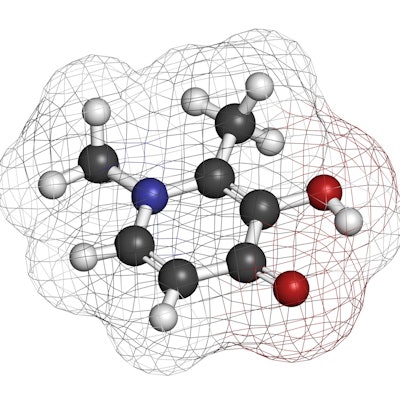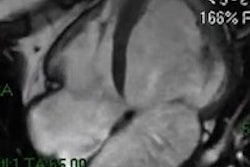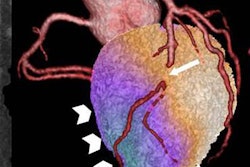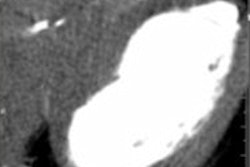
Women appear to tolerate iron toxicity better than men, perhaps due to the effect of reduced sensitivity to chronic oxidative stress, and female thalassemia patients only require follow-up every two years, according to a large Italian study.
Researchers from across the nation assessed 1,711 thalassemia patients (899 women, 31.1 ± 9.1 years) consecutively enrolled in the Myocardial Iron Overload in Thalassemia (MIOT) project. Thalassemia is an inherited blood disorder in which the body makes an abnormal form of hemoglobin.
Using MRI, the team investigated myocardial iron overload with the multislice multiecho T2* technique. They quantified biventricular function by cine images and acquired late-gadolinium enhancement images to detect myocardial fibrosis.
"We prospectively assessed if the male gender was associated with a higher risk of progressive cardiac iron accumulation, development of biventricular dysfunction and myocardial fibrosis assessed by cardiovascular magnetic resonance (CMR), and development of cardiac complications including heart failure (HF), arrhythmias, and pulmonary hypertension in thalassemia major patients," noted lead author Dr. Alessia Pepe, from the CMR Unit at Fondazione G. Monasterio, CNR-Regione Toscana, Pisa, in a poster presentation at the recent European Society of Cardiology Congress (ESC 2016) in Rome.
Although men and women had a similar risk of accumulating iron, men were at a significantly higher risk of developing cardiac dysfunction, HF, arrhythmias, and cardiac complications, she stated (see table).
| Results | |||
| Cox regression | |||
| Males vs. females | % with outcome | Hazards ratio (95% confidence index) |
p-value |
| Global heart T2* < 20 msec | 23.2 vs. 28.5 | 0.93 (0.77-1.27) | 0.470 |
| Ventricular dysfunction | 36.3 vs. 23.2 | 1.84 (1.52-2.23) | < 0.0001 |
| Myocardial fibrosis | 18.1 vs. 18.5 | 1.17 (0.89-1.53) | 0.247 |
| Heart failure | 13.3 vs. 6.3 | 2.57 (1.86-3.55) | < 0.0001 |
| Arrhythmias | 7.8 vs. 4.5 | 2.17 (1.46-3.23) | < 0.0001 |
| Pulmonary hypertension | 0.9 vs. 0.8 | 1.51 (0.52-4.35) | 0.446 |
| Cardiac complications | 20.2 vs. 10.8 | 2.31 (1.79-2.97) | < 0.0001 |
Patients were divided into two groups based on follow-up duration. The researchers found a significant gender-specific difference in the frequency of ventricular dysfunction and cardiac complications among patients followed for at least 20 years.
"Two subgroups of patients were identified: patients followed for less than 20 years and patients followed for more than 20 years," they wrote. "In the first subgroup, males and females had a comparable risk of developing cardiac iron overload, ventricular dysfunction, and cardiac complications. Conversely, if a follow-up longer than 20 years was considered, males exhibited a significantly higher risk of having ventricular dysfunction, heart failure, arrhythmias, and cardiac complications."
Impact of pregnancy
Another ESC 2016 study presented by Pepe and colleagues focused on pregnancy in women with transfusion-dependent thalassemia.
From the 956 women with hemoglobinopathies of reproductive age enrolled in the MIOT project, they selected 17 women with thalassemia (14 with thalassemia major and three with transfusion-dependent thalassemia intermedia) who had had a pregnancy and successful delivery, and on whom an MRI scan was performed before and after pregnancy.
The initial MRI was performed 15 ± 5.3 months before the delivery, while the second was carried out 5.7 ± 4.45 months later. For 16 new mothers, the second MRI was performed after the restart of the chelation therapy, specifically 3.95 ± 4.1 months later. For one new mother, the second MRI was carried out about three months before restarting the chelation therapy.
The prepregnancy and postpartum global heart T2* values and number of pathological segments were comparable. Two patients with a normal global heart T2* values (greater than 20 ms) before pregnancy showed a pathological postpartum value.
After pregnancy, there was a significant increase in MRI liver iron concentration values. On the prepartum MRI, six patients had a liver iron concentration value of less than 3 mg/g/dw, while on the postpartum MRI scans, all patients had a pathological liver iron concentration value. Among the biventricular volumetric and functional parameters, there was a significant increase in the right ventricular end-systolic volume index and a significant reduction of right ventricular ejection fraction.
In transfusion-dependent patients, cessation of chelation therapy can cause rapid iron overload, and women should be monitored carefully for iron loading and cardiac status before they embark upon a pregnancy, plus afterwards, according to the authors, who recommend offering chelation therapy immediately after delivery.
"In women showing severe iron overload before pregnancy, desferrioxamine should be started after the middle of the second trimester," they pointed out. "The negative impact on the RV (right ventricular) parameters could reflect the effect of the high cardiac output state that overcomes the physiological changes during pregnancy."
Editor's note: The image on the home page shows a deferiprone thalassemia major drug molecule.



















